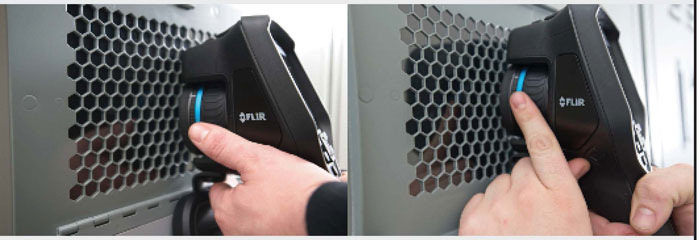Inspection & Maintenance Of A Three-Phase Pad Mounted Transformer
Work safely without opening cabinets; avoid Outages that lead to customer dissatisfaction
The customer’s challenge

Opening a cabinet to perform maintenance on a pad-mounted transformer presents an inherent safety risk. The person conducting the inspection needs to be a qualified technician with the proper electrical safety training and the appropriate Personal Protective Equipment (PPE). These safety guidelines are meant to protect workers, but can’t completely remove all risk. Unseen critical issues could be hiding behind closed cabinet doors, leading to shock hazards or even an arc flash event. Before a technician can open the cabinet doors, they must complete a Job Safety Analysis (JSA) and a Job Hazard Analysis (JHA) – necessary steps that can add significant time to the job. Multiple technicians may be needed to perform the scheduled maintenance, increasing overall costs, while mandatory maintenance schedules established by insurance companies may require specific inspection and maintenance activities.
A Solution
Combining an infrared camera and IR Windows can provide a multitude of benefits. Some companies find that installing a pair of IR Windows – one on the LV side and another on the HV side – allows inspectors to perform quick and safe inspections using an IR camera. IR Windows allow inspectors to determine whether any corrective measures are needed without having to open the cabinet doors. FLIR IRWx-PS large-format windows are designed to meet IP67/NEMA 6, with dust/water resistant protection and anti-corrosion features. The FLIR E75 can record visual, thermal, and enhanced thermal images to help inspectors identify hot spots. It features on-screen area measurement, a range of auto-calibrating optics, and a Wi-Fi connection to smart devices for sharing images and reports from the field.

With IR Windows, inspections can be performed more efficiently because the cabinet remains closed at all times. Here, a pair of JR Windows are installed on the LV and HV side of a pad-mounted transformer, allowing a more comprehensive view of the equipment inside
The Result
IR Windows paired with an inspection routine using IR cameras allow companies to be proactive rather than reactive, catching major issues before they escalate enough to cause an outage. IR Windows can significantly reduce inspection times because inspectors armed with IR cameras can scan through the windows for issues with overheating terminations, cables or windings. Companies may find this combination not only saves money through faster inspection times, but also through efficiency. This improved process could also allow companies to increase the number of inspections, ensuring transformer reliability.
For more information about FLIR in electric power distribution or to schedule a product demonstration visit:
www.teledyneflir.in/power-distribution




